| THE UNCANNY CEPHALOPODS - PART I |
Assuming you already know what a Cephalopod is, the following three pages will be running
through fifteen Cephalopod groups of most exceptional strangeness. Photos have been gleaned off
public image servers or sent to me by readers - original credits could rarely be found. If you own any
of the images used here, let me know via e-mail and I'll add the proper credits!
through fifteen Cephalopod groups of most exceptional strangeness. Photos have been gleaned off
public image servers or sent to me by readers - original credits could rarely be found. If you own any
of the images used here, let me know via e-mail and I'll add the proper credits!
Octopuses of the genus Grimpoteuthis and a number of others earn this common name from the
comical, flapping fins resembling an elephant's ears. Inhabitants of the nearly lightless, sparsely
colored deep-sea abyss, they lack the advanced camouflage abilities of other octopods but may
confuse predators with transparency, bioluminescence or both. Instead of suckers, their consistently
webbed tentacles are lined with hair-like sensory filaments called cirrae.
These cute little critters are sometimes known as flapjack octopuses, for their habit of flattening out
against the sea bed in a creeping, crawling puddle.
You can view some particularly stunning shots of a dumbo (and other marine animals) in this
gallery. Don't miss it!
comical, flapping fins resembling an elephant's ears. Inhabitants of the nearly lightless, sparsely
colored deep-sea abyss, they lack the advanced camouflage abilities of other octopods but may
confuse predators with transparency, bioluminescence or both. Instead of suckers, their consistently
webbed tentacles are lined with hair-like sensory filaments called cirrae.
These cute little critters are sometimes known as flapjack octopuses, for their habit of flattening out
against the sea bed in a creeping, crawling puddle.
You can view some particularly stunning shots of a dumbo (and other marine animals) in this
gallery. Don't miss it!
| #15 - the Dumbo Octopuses |



| #14 - the Colossal Squid |
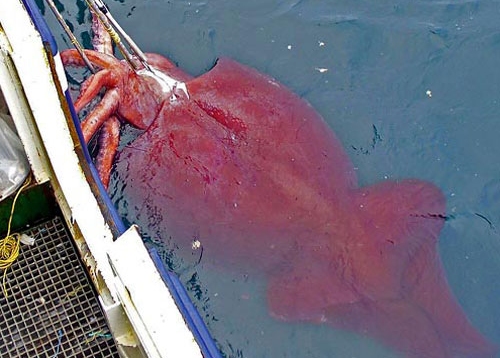
Mesonychoteuthis hamiltoni is currently considered the largest invertebrate known to man, with an
estimated adult length between forty and sixty feet. While the suckers of many squid are ringed with
tiny barbs, this ferocious monster bears suckers with massive, hook-like talons. They are known
from few specimens, and inhabit freezing arctic waters where they are believed to prey on large fish
as well as their own kind. Though impressive, this behemoth is only #14 in the list because it
deviates very little from other, smaller squid. It's not about the size of your mollusk, but what you do
with it.
estimated adult length between forty and sixty feet. While the suckers of many squid are ringed with
tiny barbs, this ferocious monster bears suckers with massive, hook-like talons. They are known
from few specimens, and inhabit freezing arctic waters where they are believed to prey on large fish
as well as their own kind. Though impressive, this behemoth is only #14 in the list because it
deviates very little from other, smaller squid. It's not about the size of your mollusk, but what you do
with it.
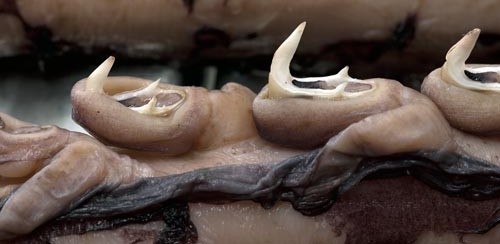
| #13 - Pygmy Squid |
At the opposite end of the spectrum, the Idiosepiidae or "pygmy squid" are the smallest of
all the decapodiformes, with adults often less than an inch in length. They make their
home in warm, shallow waters among blades of sea grass, which they cling to by a unique
patch of adhesive cells along their backs. Eggs are attached to vegetation in rows, and
closely guarded by the female.
all the decapodiformes, with adults often less than an inch in length. They make their
home in warm, shallow waters among blades of sea grass, which they cling to by a unique
patch of adhesive cells along their backs. Eggs are attached to vegetation in rows, and
closely guarded by the female.
| #12 - Joubiniteuthis portieri |
Very little is known about this deep-sea hunter, with unusually long arms and an even more
unusual "tail" bearing its own set of fins. It seems to employ a passive ambush-style hunting
technique, dangling its arms in the water to entangle passing fish. Fins placed so far from
the tentacles and mouth may make it less likely for their motion to disturb prey, but this is just
conjecture on my own part.
unusual "tail" bearing its own set of fins. It seems to employ a passive ambush-style hunting
technique, dangling its arms in the water to entangle passing fish. Fins placed so far from
the tentacles and mouth may make it less likely for their motion to disturb prey, but this is just
conjecture on my own part.
| #11 - Coconut Octopus |
Okay, stop giggling.
It's easy for an octopus to camouflage itself amongst aquatic vegetation and colorful reefs, but
Amphioctopus marginatus frequents shallow, sandy waters where the monotonous scenery is often
only broken by the sunken shells of coconuts. By bunching itself into a tight, dark ball, it takes on
the appearance of this fallen fruit and "tip toes" away as though rolling in the current. The only
other species to demonstrate this bipedal motion is Abdopus aculeatus, which prefers to walk
around in the guise of seaweed. This is not, however, the only coconut-related defense by an
octopus...
It's easy for an octopus to camouflage itself amongst aquatic vegetation and colorful reefs, but
Amphioctopus marginatus frequents shallow, sandy waters where the monotonous scenery is often
only broken by the sunken shells of coconuts. By bunching itself into a tight, dark ball, it takes on
the appearance of this fallen fruit and "tip toes" away as though rolling in the current. The only
other species to demonstrate this bipedal motion is Abdopus aculeatus, which prefers to walk
around in the guise of seaweed. This is not, however, the only coconut-related defense by an
octopus...
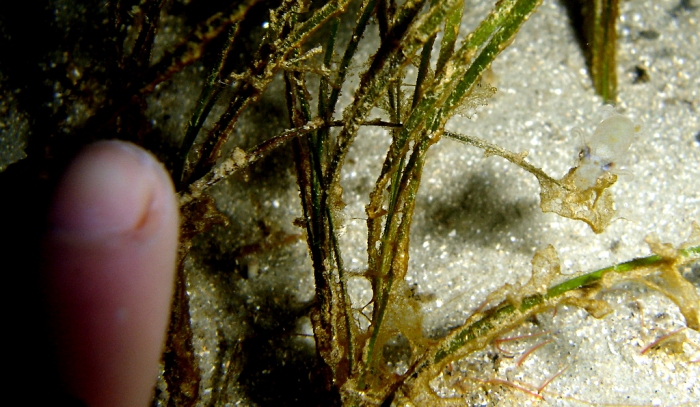
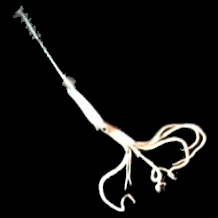
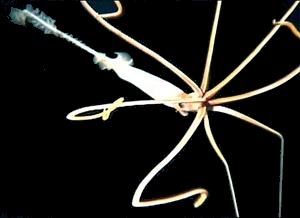
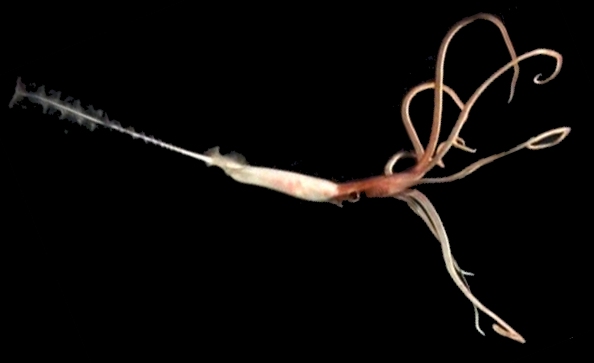
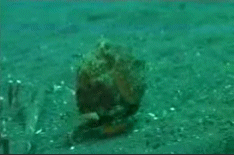
| Written by Jonathan C. Wojcik - Photo credits unknown or from public news outlets. |
| Image copyright MBARI |
| Images from Tolweb |
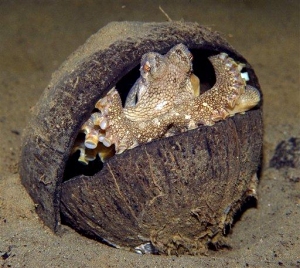
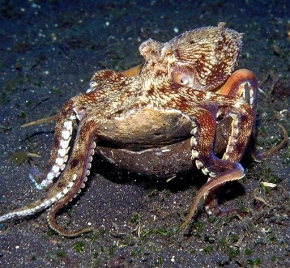
When they're not role-playing coconuts themselves, marginatus species have also been observed
carrying one or both halves of an empty coconut shell in their suckers as a sort of armored "suit,"
one of the first recorded instances of tool use in invertebrates.
carrying one or both halves of an empty coconut shell in their suckers as a sort of armored "suit,"
one of the first recorded instances of tool use in invertebrates.